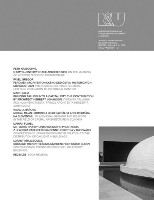Fenomén architektonického dedičstva v historických súvislostiach
Phenomenon of Architectural Heritage in Relation to Historical Context
Author(s): Pavel GregorSubject(s): Cultural Essay, Political Essay, Societal Essay
Published by: Historický ústav SAV, v. v. i.
Keywords: Architectural heritage; history; conservation; monument
Summary/Abstract: Modern conception of conservation and restoration of architectural heritage results from a long historical process. Its theoretical foundations were established in the course of the 18th century, most notably in the works of J. J. Winckelmann, as a result of tension between rationalism and romanticism and appreciation of the artistic and historical dimension of ancient buildings. The theories of Winckelmann, as well as those of his successors – J. Ruskin, W. Morris, A. Riegl and M. Dvořák – are based on analysis of the attitudes and stance of the society towards monuments of the past that has often presented a relationship full of turnovers and contradictions. The notion of a monument was already present in the ancient history: Egyptian mastabas and pyramids were intended to preserve the legacy of pharaohs for the following generations and were an object of respect and worship, in the same way as the tombs of Persian kings. On the other hand, their ideological content and close connection to the political regimes or religions provided a motive for their destruction. Besides sacred symbols, as early as in the most ancient periods there was noticed an existence of sacred places of specific significance dedicated to religious ceremonies. They subsequently became a subject for worshiping and religious veneration. Such places and related buildings can be understood as the first and oldest protected heritage. First examples of a pious attitude of the society towards architectural works as such can be found in the ancient history, although initially this attitude was a result of their symbolic indirect values rather than their historical, architectural or artistic values. Recent research presents various approaches to restoration of the classical temples. In some cases restoration preserved the original substance and style, although it was not a general rule. Classical Greek temples were frequently adapted to new purposes and contemporary style, in particular during the Roman period. At this time construction of so-called intended monuments (triumphal arches, columns, commemorative plaques) as witnesses of important historic events and characters was a common practice. Furthermore, even specific regulations for ensuring a harmony of new buildings in relation to the existing structure were already known in ancient Rome. One of the essential theoretical works on architecture by Marcus Vitruvius Pollius (De Architectura) pays special attention to the well mastered construction skills, as well as to the maintenance of the buildings. Since the Roman Empire adopted Christianity in the 4th century AD, reuse of parts of older structures in construction of new buildings became more frequent and widespread practice. This practice lead to increasing vandalism in relation to the pagan temples, tombs and public buildings, but consequently also to a revival of the classical styles, old traditions and to the first legal acts on protection and maintenance of public
Journal: Architektúra & Urbanizmus
- Issue Year: 43/2009
- Issue No: 1-2
- Page Range: 10-29
- Page Count: 20
- Language: Slovak

